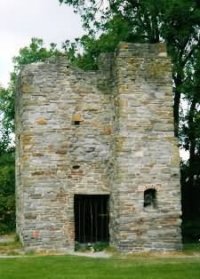Bottle Green & Coal Black
If one were to paint a history of Nailsea, what would be the one key colour common to every picture?
Surely it would be that of the pennant sandstone which underlies the town and has provided building stone since the Roman occupation. Its basic hue is akin to estuary mud, but an examination of local walls reveals several variations of coral pink-brown. A good example of these muted colours is the new retaining wall at Bucklands Batch.

Winding Tower on Scotch Horn
It is generally assumed that the Romans quarried stone here as they did for lead on the Mendips, and it is likely that the villa at Gatcombe in Long Ashton, served as the administrative headquarters for these and other operations. In skilled hands the local stone can be split into slabs of a fairly uniform thickness suitable for flagstones and roofing tiles.
The presence of pennant sandstone in Nailsea, Portbury and many areas of Bristol gave rise to coal mining which flourished locally for some four hundred years. The seams, sandwiched between layers of stone up to thirty feet thick, sweep in a great arc from the North Street / Union Street area, run parallel to Silver Street and High Street, through Trendlewood and down to Backwell Common.
The earliest date for coal mining in Nailsea is 1507 when coal was being transported to fire the limekiln at Yatton. At this period the coal would only have been mined where it outcropped near the surface, but by the mid nineteenth century the Golden Valley Pit operated at a depth of six hundred and twenty feet. Whilst some seams were up to three feet six inches thick, others were only eighteen inches and barely viable. The last pit closed in 1882 in the face of competition from larger mines in South Wales and the North of England where the coal was easier and cheaper to extract.
Several examples of winding and pumping houses remain, three as ruins, two as conversions into dwellings. The most obvious is the small winding tower and horse whim in the Millennium Park, but of national importance is the Middle Engine Pit complex in Golden Valley, now a scheduled monument.
If stone was the catalyst for coal mining, it was the abundance of this good quality coal that attracted a glassworks to Nailsea in 1788. Established on the open heath against the Nailsea / Wraxall border, John Robert Lucas initially built two cones – one for bottle making, the other for the production of window glass for the so-called Industrial Revolution. His works was to prosper under several partnerships, and by the mid nineteenth century had become the fourth largest glassworks in Britain covering some six acres between the Royal Oak Public House and Nailsea Park. Crown, cylinder and plate glass were produced, along with a limited amount of coloured. However, it was the “end of shift” domestic ware and novelty pieces made by the skilled and apprentice blowers that have accorded Nailsea glass its international recognition.
When the glassworks closed in 1873, and the last mine within the following ten years, most of the skilled workers moved away and Nailsea reverted to a largely agricultural community. After the initial decline in the population, it remained fairly static until the middle of the last century. So it was that in the late 1950's, Nailsea, a village which had inherited an unusually large population, was selected by Somerset County Council as a site for a new town.
Briefly we have traced the link between Nailsea today and pennant sandstone which started the chain reaction. Should you wish to explore this rich industrial heritage – including tanning, boot and shoe making, and cider – the Local History Society has produced over fifty books and pamphlets, many of which are on sale in the Library, and at retail outlets. If you have not already done so, why not visit the Scotch Horn Community Centre to view the display cases, murals and photo montage all relating to the history of Nailsea.
